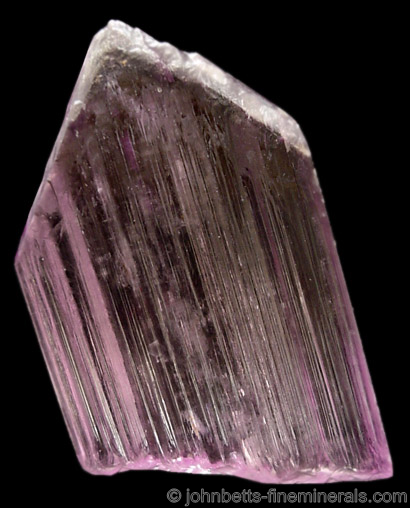The Mineral spodumene

Spodumene is a fairly prevalent mineral, but mostly dull and uninteresting in its most common forms. However, its two distinctly colored transparent varieties, Kunzite (pink) and Hiddenite (green) are very aesthetic and valued as gemstones. Hiddenite is much rarer than Kunzite, and can is highly valued, especially the deeper green color forms. Strictly speaking, Hiddenite comes from only one locality in the world - Hiddenite, North Carolina. However, as newer deposits of green Spodumene have been discovered in Afghanistan and Brazil, this term has been applied to all forms of transparent green Spodumene worldwide.
Kunzite is known for its lovely pink color that is very distinct. However, its color may slightly fade upon
prolonged exposure to sunlight. Heat treatment is sometimes applied to Spodumene, by transforming transparent brownish and greenish-brown stones into light green or pink colors. Lightly colored pink stones are also heat treated to intensify their pink color.
Spodumene is strongly pleochroic. The pleochroism is easily observed in many transparent crystals, where the color ranges from yellow to violet when viewed at different angles. Pink Kunzite will often exhibit a deeper pink color on crystal terminations due to the pleochroism.
Spodumene can grow into enormous crystals. The largest single crystal found is a well-crystallized, 42 foot (12.8 meter) giant. Even the transparent gem forms can come in huge gemmy water clear crystals so large that need to be held with both hands. Spodumene is rarely seen on a matrix as it easily pops out of the host rocks. Because of their rarity, matrix specimens are highly sought after.
Spodumene easily alters to other minerals (most often to feldspars and micas), and into clay. Sometimes, a crystal may be only partially altered, creating fascinating and intriguing specimens.
For additional information, see the gemstone section on Spodumene, Kunzite, and Hiddenite.
Chemical Formula
LiAlSi2O6
Color
White, colorless, gray, pink, violet, green, yellow, brown. Occasionally multicolored, and often displaying strong pleochroism.
Crystal System
Monoclinic
Properties
Streak
White |
Hardness
6.5 - 7 |
Transparency
Transparent to opaque |
Specific Gravity
3.1 - 3.2 |
Luster
Vitreous, silky |
Cleavage
1,2 - prismatic at cleavage angles of 87º and 93º (Characteristic of minerals in the pyroxene group). May also exhibit parting in one direction. |
Fracture
Uneven, splintery (with tough splinters) |
Tenacity
Brittle |
Other ID Marks
May fluoresce white to blue in shortwave, and dark orange to orange-red in longwave.
|
Varieties
-
Green chromium-rich transparent variety of Spodumene. Originally used strictly describing the green Spodumene from the Hiddenite area in North Carolina, this term is commonly also used referencing other green forms from Afghanistan and Brazil.
-
Pink to violet transparent variety of Spodumene.
-
Colorless to yellow transparent variety of Spodumene. (This term may also be used as a synonym of Spodumene.)
Uses
Spodumene is a very important ore of the element lithium. Huge crystals are commercially mined for extraction of this element. The transparent pink and green varieties, Hiddenite and Kunzite, are used as gemstones. Well crystallized specimens are very popular among mineral collectors.
Noteworthy Localities
The most exceptional crystals, in the form transparent tall crystals ranging in all sizes, come from the famous pegmatites of Afghanistan in the Konar Valley; Paprok, in Nuristan Province; and at the Mawi and Darra-i-Pech pegmatites in Laghman Province. Other important worldwide localities are Galiléia and Resplendor, Doce valley, Minas Gerais, Brazil; Ampatsikahitra, Sahatany Valley, Madagascar; and Alto Ligonha, Zambezia Province, Mozambique.
The U.S. has several important Spodumene localities. Outstanding Kunzite comes from the Pala District of San Diego Co., California, where this gem variety was first identified. Specific noteworthy claims in Pala include the Pala Chief Mine, the Oceanview Mine (especially the "Big Kahuna Pocket" of 2009-2010), the Elizabeth R. Mine, the Vanderberg Mine, the Katerina Mine, and the San Pedro Mine. Another Kunzite locality in San Diego Co. is the Beebe Hole Mine, in Jacumba. Hiddenite is famous at the localities of Hiddenite and Stony Point in Alexander Co., North Carolina.
There are also some well known Spodumene localities in New England, specifically Newry, Oxford Co., Maine; Branchville, Fairfield Co., Connecticut; and the Strickland Quarry, Portland, Middlesex Co., Connecticut. Large white well-terminated crystals once came from Hampshire Co., Massachusetts at both Walnut Hill in Huntington; and at the Barrus Farm in Goshen.
Other well-known Spodumene deposits include the Foote Lithium Mine, Kings Mountain, Cleveland Co., North Carolina; the Etta Mine, Keystone, Black Hills, Pennington Co., South Dakota; and the Harding Mine, near Dixon, Taos Co., New Mexico.
Distingushing Similar Minerals
Feldspars - Slightly softer (6), different cleavage and fracture.
Amblygonite - Softer.